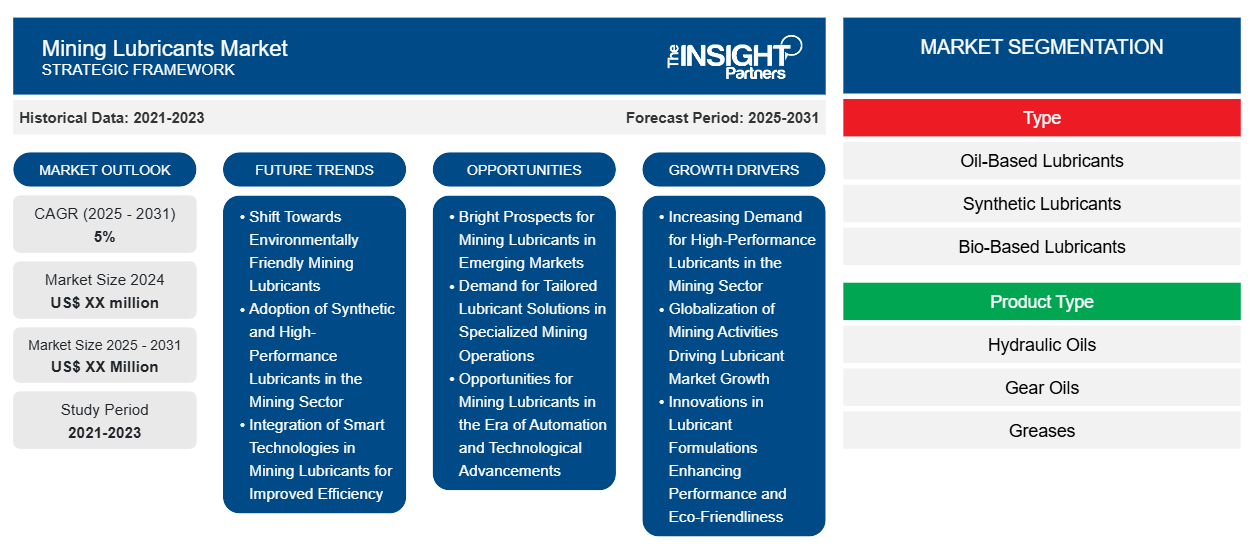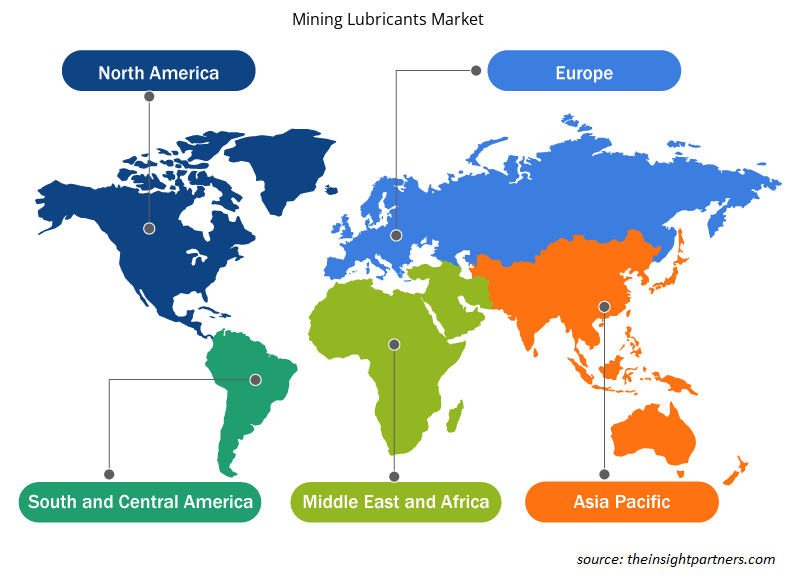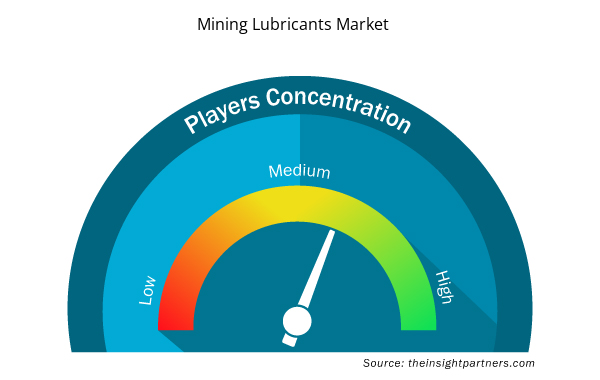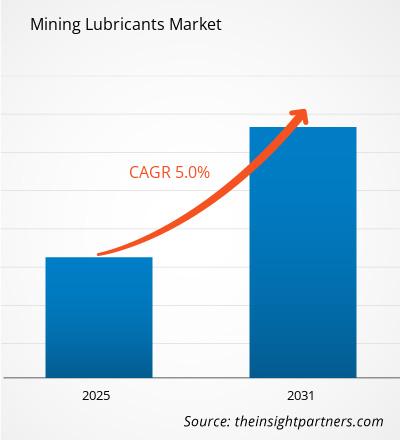Se espera que el mercado de lubricantes para minería registre una CAGR del 5% entre 2025 y 2031, con un tamaño de mercado que se expandirá de US$ XX millones en 2024 a US$ XX millones en 2031.
El informe está segmentado por tipo (lubricantes a base de aceite, lubricantes sintéticos, lubricantes de base biológica) y tipo de producto (aceites hidráulicos, aceites para engranajes, grasas, etc.). Además, presenta un análisis basado en la aplicación (minería de carbón, minería de hierro, minería de metales preciosos, minería de metales industriales, etc.). El análisis global se desglosa a nivel regional y por países principales. Geográficamente, el mercado se divide en América del Norte, Europa, Asia Pacífico, Oriente Medio y África, y América del Sur y Central. El informe ofrece el valor en USD para el análisis y los segmentos mencionados.
Propósito del Informe
El informe "Mercado de Lubricantes para Minería" de The Insight Partners busca describir el panorama actual y el crecimiento futuro, los principales factores impulsores, los desafíos y las oportunidades. Esto proporcionará información a diversos actores del sector, como:
- Proveedores/Fabricantes de Tecnología: Para comprender la dinámica cambiante del mercado y conocer las oportunidades potenciales de crecimiento, lo que les permitirá tomar decisiones estratégicas informadas.
- Inversores: Realizar un análisis exhaustivo de tendencias respecto a la tasa de crecimiento del mercado, las proyecciones financieras del mercado y las oportunidades que existen en toda la cadena de valor.
- Organismos reguladores: Regular las políticas y las actividades policiales en el mercado con el objetivo de minimizar el abuso, preservar la confianza de los inversores y defender la integridad y estabilidad del mercado.
Segmentación del mercado de lubricantes para minería
Tipo
- Lubricantes a base de aceite
- Lubricantes sintéticos
- Lubricantes de base biológica
Tipo de producto
- Aceites hidráulicos
- Aceites para engranajes
- Grasas
- Otros
Solicitud
- Minería de carbón
- Minería de mineral de hierro
- Minería de metales preciosos
- Minería de metales industriales
- Otros
Geografía
- América del norte
- Europa
- Asia-Pacífico
- América del Sur y Central
- Oriente Medio y África
Personalice este informe según sus necesidades
Obtendrá personalización en cualquier informe, sin cargo, incluidas partes de este informe o análisis a nivel de país, paquete de datos de Excel, así como también grandes ofertas y descuentos para empresas emergentes y universidades.
Mercado de lubricantes para minería: Perspectivas estratégicas

- Obtenga las principales tendencias clave del mercado de este informe.Esta muestra GRATUITA incluirá análisis de datos, desde tendencias del mercado hasta estimaciones y pronósticos.
Factores que impulsan el crecimiento del mercado de lubricantes para minería
- Aumento de la demanda de lubricantes de alto rendimiento en el sector minero: El aumento de la eficiencia operativa en el sector minero ha generado un aumento en la demanda de lubricantes de alto rendimiento. Para reducir la fricción, el desgaste y el tiempo de inactividad, los lubricantes para minería facilitan el libre movimiento de las máquinas en condiciones extremas, lo que a su vez impulsa el mercado de la lubricación de equipos y maquinaria pesada.
- La globalización de las actividades mineras impulsa el crecimiento del mercado de lubricantes: La globalización de las actividades mineras, especialmente en regiones en desarrollo como África y Asia, está influyendo positivamente en el crecimiento del mercado de lubricantes para minería. El aumento de proyectos mineros, tanto nuevos como ya existentes, genera demanda de aceites y grasas lubricantes para el mantenimiento y la protección de los equipos mineros, lo que impulsa el crecimiento del mercado.
- Innovaciones en formulaciones de lubricantes que mejoran el rendimiento y el respeto al medio ambiente: Las innovaciones en la formulación de lubricantes mejoran y prolongan su rendimiento, a la vez que aumentan su respeto al medio ambiente. Hoy en día, los lubricantes de minería de alto rendimiento son capaces de soportar altas presiones, altas temperaturas y la concentración de impurezas, lo que aumenta la demanda de las empresas mineras para prolongar la vida útil de la maquinaria y reducir el tiempo de inactividad por mantenimiento.
Tendencias futuras del mercado de lubricantes para minería
- Cambio hacia lubricantes mineros ecológicos: Considerando las medidas ambientales más estrictas y la alta concienciación sobre la sostenibilidad, actualmente se observa una tendencia hacia el uso de lubricantes mineros más respetuosos con el medio ambiente. En estas industrias, que buscan promover prácticas mineras más ecológicas, estos lubricantes están diseñados para no generar altos niveles de emisiones ni contaminación, a la vez que cumplen con las estrictas normativas ambientales.
- Adopción de lubricantes sintéticos de alto rendimiento en el sector minero: El sector minero también está adoptando gradualmente el uso de lubricantes sintéticos de alto rendimiento. Estos lubricantes se utilizan a temperaturas y presiones extremadamente altas, lo que prolonga la vida útil de los equipos y reduce el costo de las reparaciones, lo que los hace más prácticos en la minería a gran escala.
- Integración de tecnologías inteligentes en lubricantes mineros para una mayor eficiencia: Los lubricantes mineros también han integrado tecnologías inteligentes en sus sistemas, como la tecnología IoT. Se utilizan sensores IoT y análisis de datos para monitorear el estado y las condiciones de los lubricantes, lo que permite que el proceso funcione incluso antes de que se agoten. Esto mejora las actividades mineras al aumentar la productividad y reducir la inactividad de la maquinaria.
Oportunidades del mercado de lubricantes para minería
- Perspectivas prometedoras para los lubricantes mineros en mercados emergentes: Con el desarrollo de operaciones mineras en nuevas regiones como África, Latinoamérica y Asia, las perspectivas del mercado de lubricantes mineros son prometedoras. Estas regiones están experimentando una mayor demanda de lubricantes de alta calidad para respaldar el alto nivel de actividad minera, lo que proporciona un amplio mercado disponible para sus proveedores.
- Demanda de soluciones de lubricantes a medida en operaciones mineras especializadas: Ante la necesidad de operaciones más especializadas y eficientes, las empresas mineras buscan soluciones de lubricantes a medida para equipos específicos en entornos específicos. Esto facilita que los fabricantes de lubricantes creen productos únicos que mejoren el rendimiento y prolonguen la vida útil de los equipos, a la vez que reducen los costos de mantenimiento.
- Oportunidades para los lubricantes mineros en la era de la automatización y los avances tecnológicos: A medida que las operaciones mineras adoptan niveles de automatización, incluyendo vehículos autónomos, existe la posibilidad de que los lubricantes mineros adquieran nuevas dinámicas y se adapten a las nuevas tecnologías. Gracias a los avances técnicos, los lubricantes mineros utilizados en sistemas y maquinaria tienden a optimizar el rendimiento y reducir el desgaste, creando un nuevo segmento de mercado en lubricantes mineros.
Perspectivas regionales del mercado de lubricantes para minería
Los analistas de Insight Partners han explicado detalladamente las tendencias y los factores regionales que influyen en el mercado de lubricantes para minería durante el período de pronóstico. Esta sección también analiza los segmentos y la geografía del mercado de lubricantes para minería en América del Norte, Europa, Asia Pacífico, Oriente Medio y África, y América del Sur y Central.

- Obtenga los datos regionales específicos para el mercado de lubricantes para minería
Alcance del informe del mercado de lubricantes para minería
| Atributo del informe | Detalles |
|---|---|
| Tamaño del mercado en 2024 | US$ XX millones |
| Tamaño del mercado en 2031 | US$ XX millones |
| CAGR global (2025-2031) | 5% |
| Datos históricos | 2021-2023 |
| Período de pronóstico | 2025-2031 |
| Segmentos cubiertos | Por tipo
|
| Regiones y países cubiertos | América del norte
|
| Líderes del mercado y perfiles de empresas clave |
|
Densidad de actores del mercado de lubricantes para minería: comprensión de su impacto en la dinámica empresarial
El mercado de lubricantes para minería está en rápido crecimiento, impulsado por la creciente demanda de los usuarios finales debido a factores como la evolución de las preferencias de los consumidores, los avances tecnológicos y un mayor conocimiento de los beneficios del producto. A medida que aumenta la demanda, las empresas amplían su oferta, innovan para satisfacer las necesidades de los consumidores y aprovechan las tendencias emergentes, lo que impulsa aún más el crecimiento del mercado.
La densidad de actores del mercado se refiere a la distribución de empresas o compañías que operan en un mercado o sector en particular. Indica cuántos competidores (actores del mercado) hay en un mercado determinado en relación con su tamaño o valor total.
Las principales empresas que operan en el mercado de lubricantes para minería son:
- BP PLC
- Corporación Chevron
- Corporación Exxonmobil
- Fuchs Petrolub SE
- Compañía Idemitsu Kosan, Ltd.
Descargo de responsabilidad : Las empresas enumeradas anteriormente no están clasificadas en ningún orden particular.

- Obtenga una descripción general de los principales actores clave del mercado de lubricantes para minería
Puntos clave de venta
- Cobertura integral: el informe cubre exhaustivamente el análisis de productos, servicios, tipos y usuarios finales del mercado de lubricantes para minería, proporcionando un panorama holístico.
- Análisis de expertos: el informe se compila con base en el conocimiento profundo de expertos y analistas de la industria.
- Información actualizada: El informe asegura relevancia comercial debido a su cobertura de información reciente y tendencias de datos.
- Opciones de personalización: este informe se puede personalizar para satisfacer los requisitos específicos del cliente y adaptarse adecuadamente a las estrategias comerciales.
Por lo tanto, el informe de investigación sobre el mercado de lubricantes para minería puede ayudar a descifrar y comprender el panorama de la industria y sus perspectivas de crecimiento. Si bien existen algunas preocupaciones válidas, las ventajas generales de este informe suelen superar las desventajas.
- Análisis histórico (2 años), año base, pronóstico (7 años) con CAGR
- Análisis PEST y FODA
- Tamaño del mercado Valor/volumen: global, regional, nacional
- Industria y panorama competitivo
- Conjunto de datos de Excel



Report Coverage
Revenue forecast, Company Analysis, Industry landscape, Growth factors, and Trends

Segment Covered
This text is related
to segments covered.

Regional Scope
North America, Europe, Asia Pacific, Middle East & Africa, South & Central America

Country Scope
This text is related
to country scope.
Preguntas frecuentes
The report can be delivered in PDF/Word format, we can also share excel data sheet based on request.
Based on geography, North America held the largest share of the mining lubricants market.
One of the key trends in the mining lubricants market is the shifting towards ecofriendly lubricants and adoption of synthetic lubricants.
BP PLC, Chevron Corporation, Exxonmobil Corporation, Fuchs Petrolub SE, Idemitsu Kosan Co., Ltd., Petrochina Company Limited, Quaker Chemical Corporation, Royal Dutch Shell PLC, Sinopec Limited are the key players operating in the mining lubricants market.
Rising demand for efficient mining operations and expansion of mining activities are the major factors driving the mining lubricants market.
The Mining Lubricants Market is estimated to witness a CAGR of 5% from 2023 to 2031
Trends and growth analysis reports related to Chemicals and Materials : READ MORE..
1. BP PLC
2. Chevron Corporation
3. Exxonmobil Corporation
4. Fuchs Petrolub SE
5. Idemitsu Kosan Co., Ltd.
6. Petrochina Company Limited
7. Quaker Chemical Corporation
8. Royal Dutch Shell PLC
9. Sinopec Limited
10. Total S.A.
The Insight Partners performs research in 4 major stages: Data Collection & Secondary Research, Primary Research, Data Analysis and Data Triangulation & Final Review.
- Data Collection and Secondary Research:
As a market research and consulting firm operating from a decade, we have published and advised several client across the globe. First step for any study will start with an assessment of currently available data and insights from existing reports. Further, historical and current market information is collected from Investor Presentations, Annual Reports, SEC Filings, etc., and other information related to company’s performance and market positioning are gathered from Paid Databases (Factiva, Hoovers, and Reuters) and various other publications available in public domain.
Several associations trade associates, technical forums, institutes, societies and organization are accessed to gain technical as well as market related insights through their publications such as research papers, blogs and press releases related to the studies are referred to get cues about the market. Further, white papers, journals, magazines, and other news articles published in last 3 years are scrutinized and analyzed to understand the current market trends.
- Primary Research:
The primarily interview analysis comprise of data obtained from industry participants interview and answers to survey questions gathered by in-house primary team.
For primary research, interviews are conducted with industry experts/CEOs/Marketing Managers/VPs/Subject Matter Experts from both demand and supply side to get a 360-degree view of the market. The primary team conducts several interviews based on the complexity of the markets to understand the various market trends and dynamics which makes research more credible and precise.
A typical research interview fulfils the following functions:
- Provides first-hand information on the market size, market trends, growth trends, competitive landscape, and outlook
- Validates and strengthens in-house secondary research findings
- Develops the analysis team’s expertise and market understanding
Primary research involves email interactions and telephone interviews for each market, category, segment, and sub-segment across geographies. The participants who typically take part in such a process include, but are not limited to:
- Industry participants: VPs, business development managers, market intelligence managers and national sales managers
- Outside experts: Valuation experts, research analysts and key opinion leaders specializing in the electronics and semiconductor industry.
Below is the breakup of our primary respondents by company, designation, and region:

Once we receive the confirmation from primary research sources or primary respondents, we finalize the base year market estimation and forecast the data as per the macroeconomic and microeconomic factors assessed during data collection.
- Data Analysis:
Once data is validated through both secondary as well as primary respondents, we finalize the market estimations by hypothesis formulation and factor analysis at regional and country level.
- Macro-Economic Factor Analysis:
We analyse macroeconomic indicators such the gross domestic product (GDP), increase in the demand for goods and services across industries, technological advancement, regional economic growth, governmental policies, the influence of COVID-19, PEST analysis, and other aspects. This analysis aids in setting benchmarks for various nations/regions and approximating market splits. Additionally, the general trend of the aforementioned components aid in determining the market's development possibilities.
- Country Level Data:
Various factors that are especially aligned to the country are taken into account to determine the market size for a certain area and country, including the presence of vendors, such as headquarters and offices, the country's GDP, demand patterns, and industry growth. To comprehend the market dynamics for the nation, a number of growth variables, inhibitors, application areas, and current market trends are researched. The aforementioned elements aid in determining the country's overall market's growth potential.
- Company Profile:
The “Table of Contents” is formulated by listing and analyzing more than 25 - 30 companies operating in the market ecosystem across geographies. However, we profile only 10 companies as a standard practice in our syndicate reports. These 10 companies comprise leading, emerging, and regional players. Nonetheless, our analysis is not restricted to the 10 listed companies, we also analyze other companies present in the market to develop a holistic view and understand the prevailing trends. The “Company Profiles” section in the report covers key facts, business description, products & services, financial information, SWOT analysis, and key developments. The financial information presented is extracted from the annual reports and official documents of the publicly listed companies. Upon collecting the information for the sections of respective companies, we verify them via various primary sources and then compile the data in respective company profiles. The company level information helps us in deriving the base number as well as in forecasting the market size.
- Developing Base Number:
Aggregation of sales statistics (2020-2022) and macro-economic factor, and other secondary and primary research insights are utilized to arrive at base number and related market shares for 2022. The data gaps are identified in this step and relevant market data is analyzed, collected from paid primary interviews or databases. On finalizing the base year market size, forecasts are developed on the basis of macro-economic, industry and market growth factors and company level analysis.
- Data Triangulation and Final Review:
The market findings and base year market size calculations are validated from supply as well as demand side. Demand side validations are based on macro-economic factor analysis and benchmarks for respective regions and countries. In case of supply side validations, revenues of major companies are estimated (in case not available) based on industry benchmark, approximate number of employees, product portfolio, and primary interviews revenues are gathered. Further revenue from target product/service segment is assessed to avoid overshooting of market statistics. In case of heavy deviations between supply and demand side values, all thes steps are repeated to achieve synchronization.
We follow an iterative model, wherein we share our research findings with Subject Matter Experts (SME’s) and Key Opinion Leaders (KOLs) until consensus view of the market is not formulated – this model negates any drastic deviation in the opinions of experts. Only validated and universally acceptable research findings are quoted in our reports.
We have important check points that we use to validate our research findings – which we call – data triangulation, where we validate the information, we generate from secondary sources with primary interviews and then we re-validate with our internal data bases and Subject matter experts. This comprehensive model enables us to deliver high quality, reliable data in shortest possible time.

 Obtenga una muestra gratuita de este informe
Obtenga una muestra gratuita de este informe